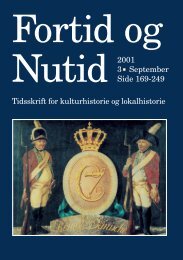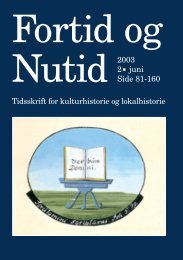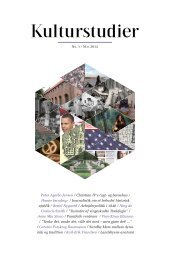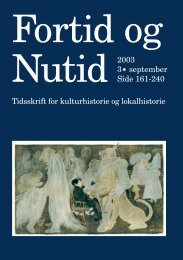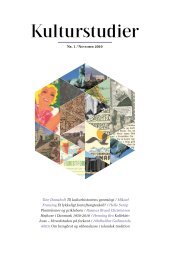Læs hele tidsskriftet (PDF) - Kulturstudier
Læs hele tidsskriftet (PDF) - Kulturstudier
Læs hele tidsskriftet (PDF) - Kulturstudier
Create successful ePaper yourself
Turn your PDF publications into a flip-book with our unique Google optimized e-Paper software.
<strong>Kulturstudier</strong> Nr. 2, 2011 The reconfigured body 4/15<br />
newspapers referred to international articles. 9 Fifteen interviews ranging from<br />
40 minutes to 2 hours in length were carried out during 2009 and 2010. The interviewees<br />
were medical researchers, researchers in the field of humanities and<br />
social sciences working with the medical researchers, politicians and one representative<br />
for an animal rights organization. The interviews were tape recorded<br />
and transcribed. All the interviews were conducted with a list of questions concerning<br />
how xenotransplantation research developed in Sweden in the 1990s. 10<br />
Through the empirical material the main focus has been to explore the discourses<br />
on how the relationships between human and animal bodies were challenged in<br />
different cultural contexts in the 1990s and early 2000s. These discourses in the<br />
material have been analysed by thematizing them into the three different issues<br />
referred to above.<br />
Equal, but not too equal<br />
One of the major problems with transplantation of animal organs into human<br />
bodies is the compatibility between these two biologically different objects. Researchers<br />
have focused on the problem of immunosuppression: that the cell, tissue<br />
or organ is rejected when adaptation to the new human environment does not<br />
succeed due to the efficiency of the immune system. The existence of concrete<br />
biological facts regarding the incompatibility between animal and human flesh<br />
made it possible to categorize the human as something different from the animal.<br />
Many of the earlier xenotransplantation experiments had used kidneys, hearts or<br />
livers from nonhuman primates such as baboons or chimpanzees in an attempt to<br />
overcome this disparity. But at the beginning of the 1990s, there was a discussion<br />
among the medical researchers at Sahlgrenska University Hospital in Gothenburg,<br />
concerning the use of nonhuman primates.<br />
In 1995 the researchers at Sahlgrenska University Hospital connected two patients’<br />
bloodstreams to pig kidneys as part of a medical trial. The kidneys were<br />
placed beside the patients in a box. In the first clinical trial, the human blood<br />
streamed through the kidney for one hour and fifteen minutes. 11 Before the trial<br />
started, the researchers discussed which donor animal to use. One of the directors<br />
of the research team remembers the discussions about using pigs and not<br />
nonhuman primates:<br />
Researcher: “Considering the number of pigs that we eat, it wasn’t so strange<br />
to use that animal. However, we felt very strongly that it was impossible to use<br />
9 This data was presented in an earlier report, see Hansson 2003.<br />
10 The material has been presented in Hansson and Lundin 2011.<br />
11 Hansson 2003.<br />
145



